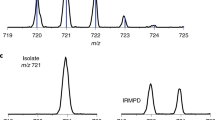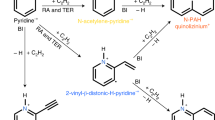Abstract
THE origin of the broad interstellar infrared emission bands (at 3.3, 6.2, 7.8, 8.6 and 11.3 μm) found in the vicinity of many galactic and extragalactic sources is still poorly understood. The original suggestion1 that the bands are associated with aromatic species embedded in small carbon particles was later challenged by the proposal2 that they originate from vapour-phase, neutral polycyclic aromatic hydrocarbons (PAHs); Allamandola et al. independently argued3 that PAH cations are the source of the bands. This latter proposal has steadily gained acceptance, but the lack of experimentally determined emission spectra of PAH cations has made it difficult to test the idea. We have recently measured the visible and infrared spectra of the neutrals and cations of four PAHs—naphthalene4, anthracene5, pyrene6 and perylene7—dispersed in argon matrices at 12 K, to approximate the low-pressure, gas-phase conditions of the interstellar medium. Here we compare the infrared absorption from these four molecules (neutrals and cations), integrated over the spectral regions corresponding to the interstellar bands, with the astronomical observations. We find that the interstellar bands cannot be explained solely on the basis of neutral PAH species, but that cations must be a significant, and in some cases dominant, component.
This is a preview of subscription content, access via your institution
Access options
Subscribe to this journal
Receive 51 print issues and online access
$199.00 per year
only $3.90 per issue
Buy this article
- Purchase on Springer Link
- Instant access to full article PDF
Prices may be subject to local taxes which are calculated during checkout
Similar content being viewed by others
References
Duley, W. W. & Williams, D. A. Mon. Not. R. astr. Sec. 196, 269 (1981).
Leger, A. & Puget, J. L. Astr. Astrophys 137, L5–L8 (1984).
Allamandola, L. J., Tielens, A. G. G. M. & Barker, J. R. Astrophys. J. 290, L25–L28 (1985).
Szczepanski, J. et al. J. phys. Chem. 96, 7876–7881 (1992).
Szczepanski, J., Vala, M., Talbi, D., Parisel, O. & Ellinger, Y. J. chem. Phys. 98, 4494–4511 (1993).
Szczepanski, J., Vala, M., Talbi, D., Parisel, O. & Ellinger, Y. J. phys. Chem. (to be submitted).
Szczepanski, J., Chapo, C. & Vala, M. Chem. Phys. Lett. 205, 434–439 (1993).
Shida, T. Electronic Absorption Spectra of Radical Ions (Elsevier, Amsterdam, 1988).
Birks, J. B. Photophysics of Aromatic Molecules (Wiley, New York, 1970).
Salama, F. & Allamandola, L. J. Nature 358, 42–43 (1992).
Andrews, L., Kelsall, B. & Blankenship, T. A. J. Am. chem. Soc. 86, 2916–2926 (1982)
Jourdain de Muizon, M., d'Hendecourt, L. B. & Gabelle, T. R. Astr. Astrophys. 227 526–541 (1990).
Zavagno, A., Cox, P. & Baluteau, J.P. Astr. Astrophys. 259, 241–251 (1992).
Pauzat, F., Talbi, D., Miller, M. D., DeFrees, D. J. & Ellinger, Y. J. phys. Chem. 96, 7882–7886 (1992).
Author information
Authors and Affiliations
Rights and permissions
About this article
Cite this article
Szczepanski, J., Vala, M. Laboratory evidence for ionized polycyclic aromatic hydrocarbons in the interstellar medium. Nature 363, 699–701 (1993). https://doi.org/10.1038/363699a0
Received:
Accepted:
Issue Date:
DOI: https://doi.org/10.1038/363699a0
This article is cited by
-
Diffuse component of the fluorescence spectrum of anthracene vapor as a function of the frequency of the exciting radiation
Journal of Applied Spectroscopy (1999)
Comments
By submitting a comment you agree to abide by our Terms and Community Guidelines. If you find something abusive or that does not comply with our terms or guidelines please flag it as inappropriate.



